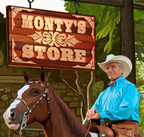How to teach a jumper not to run at a high speed towards a fence/obstacle
Rewards
Subscribe to Equus Online University and become a part of Monty's worldwide mission to leave the world a better place for horses and for people too.
Students automatically gain access to special rewards, such as exclusive discounts at the Monty Roberts Online Shop. Visit Monty Roberts Online Shop.




Hi Loren,
How long have you had this horse? I would take it right back to basics schooling to get him back on his hocks and listening to you so plenty of transitions and half halts if he starts to rush, then re-introduce trotting poles and progress from there. If you've not had him long he may well have been "fired" at the fences by previous riders.
Hi. Yes, I agree with the previous note. However, we need more info to give clear advice. How old is jumper? What is his history? How long has he been with you? Do you use dually & join up? Do you long line? SORRY, that a lot of questions! The answer to your question is this horse has been poorly trained - he has a human problem. Horses jump naturally - to escape. Many humans love to jump horses so we get our adrenaline up & that's really unhelpful as it reinforces rushing / escape mode thinking. You need to be as calm with him as you are when relaxing in a big arm chair at home in the evening. To do that I suggest taking in a huge breath & then pushing as much air as possible out. This is an instant calmer but you will need to do it repeatedly during the training sessions. Once I have more info I'll try & help you but bad advice is much worse than none at all, as it just leads to more & bigger problems, so you'll understand why I've not been too helpful yet. Cheers, Jo
Hi Loren,
I'm with Tiggy on this. Rushing a fence usually means the horse has poor skills at jumping, mainly judging the distance or how to handle the entire approach/take-off, so they solve it the best way they know; speed. Back to basics and lots of pole work.
You can also build small fences with poles in front and after to make him think BUT this demands a bit of knowledge from your side in regards to the distance between poles as well as riding skills to maintain balance etc since a horse rushing this set-up can be in danger of tripping and falling over.
Hi again Loren, very basic but I would also suggest having someone on the ground, saves a lot of work when setting up poles, they can adjust to horses stride and build small fences as & when you're both ready. The hours I've spent trying to do it all myself, on off on off!!!
I have no experience at all of jumping or training horses to jump so I am going to share my thoughts as a request for education not as giving advice. They are my logical thoughts from all the other stuff I do with horses so if it's nonsense please tell me because I am always open to learning :-)
:
Horses know how to jump - if they need to for survival they will jump within their physical capability but it takes massive energy so in order to jump as a 'profession' they need to build stamina and muscle - I get that bit.
:
My limited experience with a jumping issue I was asked to look at led to the conclusion that (a) the rider anticipating the horse would fail led to the horse failing and vice versa (b) bearing in mind horses depth perception and visual acuity, if you hold your horses head too high he can't 'see' the jump properly. Addressing these two things led to my client and her horse jumping again very successfully but this is my only experience really.
:
What I don't get (and this is where my ignorance will come to the fore and possible stupid questions!) is the strides business, the course walking, deciding for the horse how many steps he should take (can he not work it out himself?), the need to micro-manage everything the horse does, if humans walk the course, why don't we walk the horse round the course so he gets to see the changing levels, any scary new things etc. (I can hear people laughing now...can you imagine if I suggested that at a Show Jumping event, "Excuse me, can my horse walk the course?") That's why I'm asking here, because it's a safe place to ask daft questions lol
Vicci, there are no stupid questions! :) Besides, I think it is a good question to ask - the answer certainly isn't obvious to everyone.
It is a very long answer, though. Not sure I can fit it all in - I would need an entire book to give the whole picture. So bear with me in a long answer and for possibly stating the obvious. :)
.
First part:
Most horses can see their way over an obstacle if they have to - most would run around it if that is an option. ;)'Few horses have the skill to clear consecutive obstacles over 1.00 m or more while carrying a rider.
Once you enter a course, the goal is to jump it without faults usually in the fastest time possible. To do that, horse and rider needs to interact; with the rider showing its skill in guiding its horse and to make/ask it to perform in the best way it can.
.
Secondly:
Showing the horses the course is logical in the sense that they would be less surprised. In any other sense it is doubtful that the horses would understand or be able to concentrate on distances etc, given that they probably don't understand why they would have to in the first place.
But aside from the impossible logistics during a competition with more than 10 riders, there is also the matter of this being part of the point with the competition itself; the horse trusting and listening to its rider in a new environment.
.
Thirdly;
The horse *is* allowed to look at the fences/course as the rider enters just before the start. The competition lies to a great extent in the riders's ability to introduce their horses to the obstacles in the best way possible. The horse doesn't know which way to go and the rider might want to choose a shorter or longer route to the fence. Different fences requires different approaches to be cleared. The combinations, (where two or three fences come in a row with no more than three strides in between) can have distances that doesn't match the stride of your horse so the rider needs to time the approach/take-off to make the next fence. Hence the meticulous measuring of distances between them.
.
I'm stopping here but will be happy to elaborate if you want me to.
Hi Loren. I would like to point out something to you. The note you posted was at best, brief & in response we have all spent considerably more time responding than you did originally. We have asked for more information so that we can ensure that the suggestions we provide to you are the complete picture you need & not a patronising, baby step by step diatribe which you find unhelpful, but you have not yet been polite enough to respond or acknowledge our efforts. We are all happy to be generous with our experience but this needs to be a two way flow. How would you feel if you put effort into helping someone only to have them be indifferent in return? Cheers Jo.
Whoa Jo, I have to say that's a bit harsh! It's only been four days since Loren posted her comment (and it was a comment in the suggestion box for lessons we would like to see on the Uni). There may be any number of reasons why someone can't reply...let's give her some time eh? :-)
:
Kicki - thank you for your reply; very interesting. Your first and second part understood thankyou. I would like a bit more expansion on your third point (again forgive me if it's an obvious question/point). I would like to pose a hypothetical scenario. Suppose a horse has been taught to jump without a rider first (either free style or on longlines) and we discover he enjoys it (as many do) - we then bring in the rider and he learns to carry the weight and balance himself etc. Can the horse become talented enough to work out distances between combinations etc. himself based on his prior learning? I now see the point about knowing which way round to go lol (dozy me hadn't allowed for that bit!)so he would need directional guidance but I wonder if a horse could ever know that the "job" is to jump and therefore he can figure out what he needs to do i.e. set up the direction and let him go. Am I being too naieve/optimistic do you think about the capability of the horse? What do you think?
Hi. Yeah - it was but I came to this one straight from the ' scrambling ' post & my blood was up! I'd still like Loren to get back in on this though - coz there are lots of useful tips here. Jo
Hi Vicci, the answer to your last question is no but they can learn to ignore you when you get it wrong. Let me explain - my Apollo Le Sheik loved to jump, took my instructions & we were successful often. However, he would ignore me when he saw his own stride to a fence & would take off anything up to a full stride earlier - which could be a bit disconcerting. I have video of us coming to the last fence in a Team Chase, going hell for leather but when you slow it down from three strides out he goes shorter stride, flicks his ears, another short one & then launches, clearing the fence with ease & covering about 17 feet in the process ( from take off to landing ). I just stay out of his way but then we did have extraordinary trust in each other.
One day when he was a bit colicky ( off colour ) I went & sat in his stable with him. He got up, walked over & laid down putting his head in my lap. I stroked his cheeks thinking how fantastic it was to be in a friendship this close. Less than five minutes later the tears were running down my face. The weight of his head, not inconsiderable, had cut off the blood supply to my legs. I was in agony! Eventually, when I could stand it no more I had to push him off my lap. I still miss the old boy - 9 years gone but never forgotten. Jo
Vicci, I agree with Jo. I used to show jump my old mare almost every weekend, boy did she help me out at times! I would see strides that would be a mile out or bury her at the bottom of a fence, I have somewhere 2 photos, one with her almost sat on her back end where I got too close, the other with her front feet over the front rail of an older with her hinds an inch off the floor.As the fences get bigger and the courses more technical, 1/2 strides and odd distances are put in to catch horse and rider. The pro's make it look so easy but it's not if you haven't got a natural eye for it!
Useful information; thank you all for sharing it and for your support.
Since Jo and Tiggy beat me to the punch :) I just want to add that it's also a matter of talent within each horse. I suppose if you always set up the exact same combination/distance, the horse would probably learn that one based on experience, but it wouldn't do it much good in the long run.
Also, horses' eyesight don't allow them to relate to the obstacle until they are pretty close, so they are pretty much unaware of going into a combination.
Hi Kicki - sorry, I didn't realise punching was involved! Seriously, a great deal can be gained by having a horse jumping loose. Allowing ponies or horses to jump variable ( upright & spread) fences on their own is very useful. You then add in the problem of rider & extra weight with at least some experience. So often at local shows you see both children & adults on novice steads, kicking like fury before the fence when the animal clearly has little, if any, idea of how to cope with the situation. Then when it stops, runs around or 'cat leaps' ( jumps from a virtual standstill & lands on all fours) it is rewarded with either a boot in the belly or a smack from the whip. When I bought my now no longer with us old boy, when he was 14 years old he did not jump. We hacked out with his best mate from the field who did jump. There were lanes of small jumps set around some of the rides we used. His best mate loved these jumping lanes & the ' anything you can do, I can do better' syndrome set in. We followed Breeze up these lanes & guess what, we were well able to jump! Ok, in the beginning we went two feet higher than absolutely necessary because we didn't fold up our legs but we soon figured that one out. Then we discovered the joy of cross county when we were allowed to be flight horse & race for our lives. That was the best fun. One particular venue, Floors Castle in Kelso, became ours! No, we didn't buy it, but that course was the one we really loved. One year it was particularly busy & the horse lorry needed to park half a mile from the warm up & start. So we put on a show for the spectators by full passing (going completely sideways) from lorry to start. I just sat there & let him show off. One man asked why I was doing that & my reply was " the gearbox is broken"! Happy memories,!! Cheers, Jo
Kicki, I agree on the talent front,but they all have a bit of ability, lots of people expect too much!! I read a book years ago and there was a foreword by David Broome, who's dad had once said it's 80% horse and 20% rider, which I always take as the horses ability to both jump and help you out and the riders ability to stay in balance and see a decent stride to the fences!!
Oh Jo, I had to stop taking the Old Dragon x country, she knew it all and I would only have steering, luckily she was very clever and could work everything out but there would've been a day when something would go wrong!! So I stopped before that day came. Don't get me wrong I would trust her to jump the moon for me but things do happen.
As for showing off her son at his x country last year jumped the warm up fence and promptly bronco'ed with me, proper ball shape, I'm laughing as everyone else's jaws hit the floor! Over exuberance on his part, fine afterwards.
Hi Loren, I know that you have a lot of comments already, but I would just like to give you a couple suggestions that you might be able to try in order to slow down your horse before a jump:
1. So your horse if probably excited to jump over the fence and goes something like "Oh my goodness!! We're going to just this!".
2. My riding instructor always told me to sit deep in the saddle and 'dig your heels in the ground' because the horse listens mostly to your body language and it is quite hard for them to speed up when someone is sitting deep in the saddle and is interfering with their speed.
3. Do short, mini tugs on the reins to cue the horse not to go fast and to slow down at a pace you want them to go at.
4. Make sure to look strait through the horses ears so that he/she knows where to go after the jump and doesn't get confused.
5. Most of these strategies would work really well on the well trained horse so, I'm not so sure that this would work on the untrained horse - it is more likely that it would confuse them more than help.